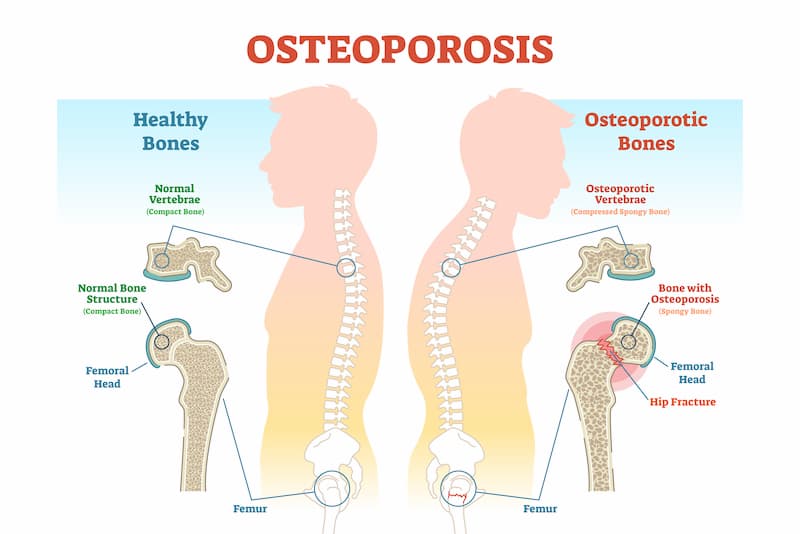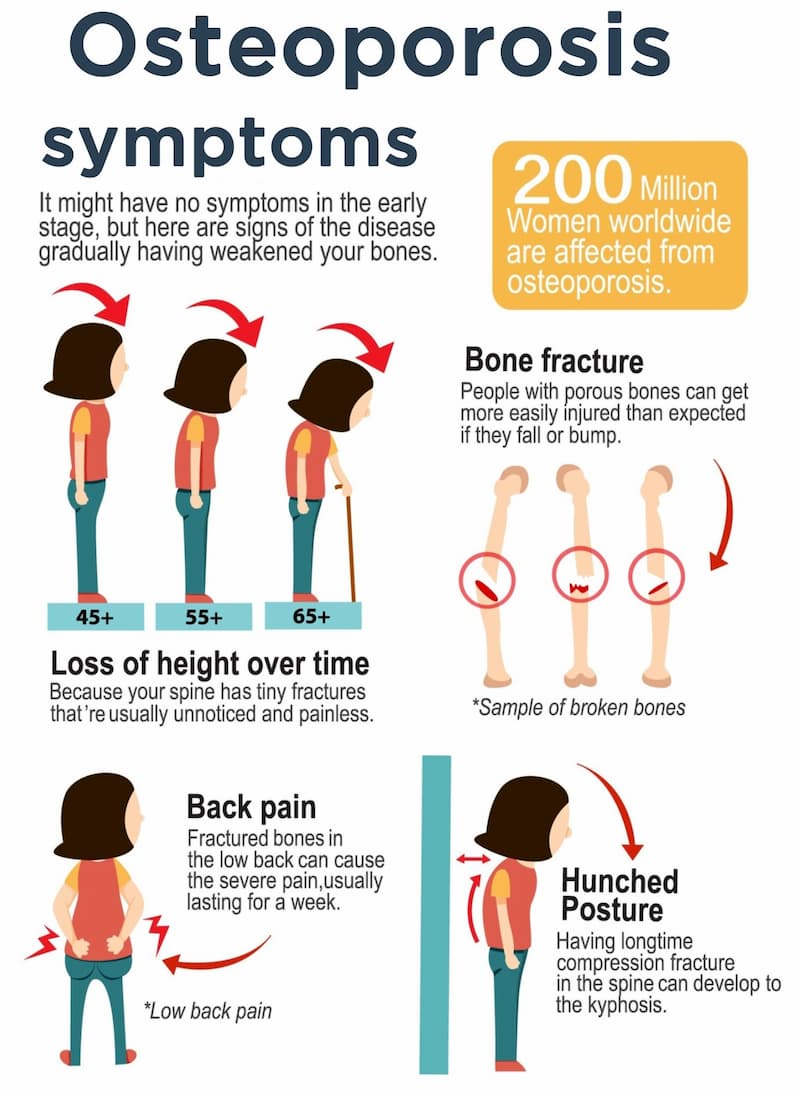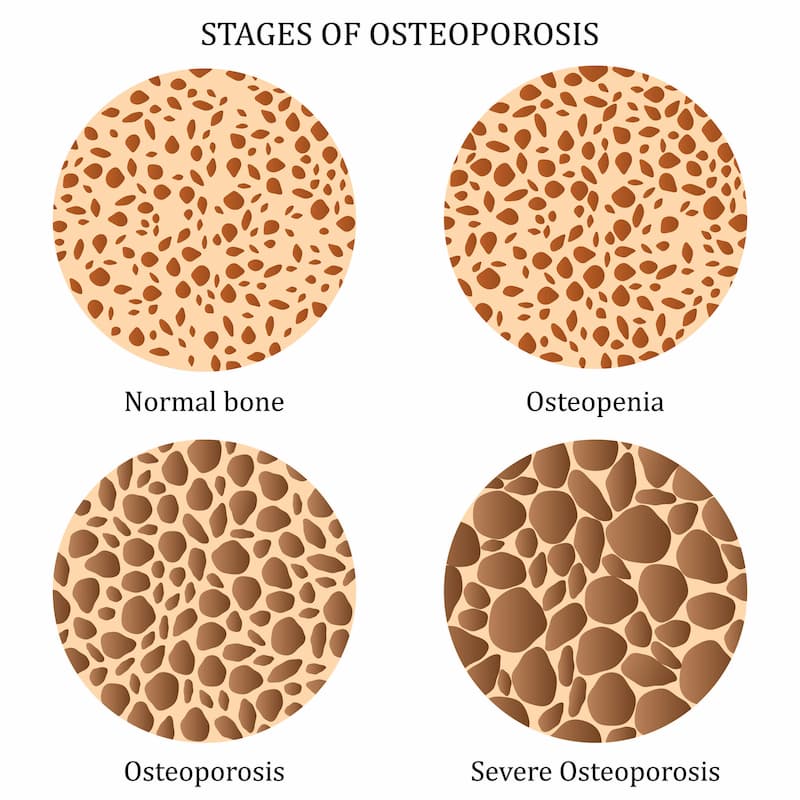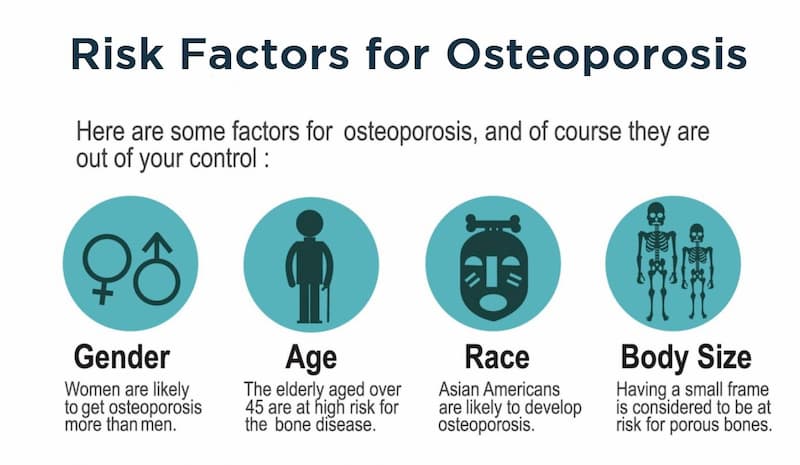Osteoporosis is sometimes referred to as the “silent disease” because it may not show noticeable signs of its presence until a serious bone fracture occurs. However, there are some signs of osteoporosis that can appear before the disease progresses too far. As the disease slowly and silently develops, bones lose density and become more porous, leading to skeletal changes that can cause pain. It is a progressive disease and not curable, but its progress can be significantly slowed. It is important to recognize the signs of osteoporosis and to begin a treatment plan immediately to prevent further bone loss.

Symptoms of Osteoporosis
Many times people learn they have osteoporosis because a bone fractures when doing something that should not break a bone, like standing up or lightly bumping an object. A bone fracture is one of the top symptoms of low bone density.

However, there are early signs of osteoporosis that may appear before a bone breaks. Following is an osteoporosis symptoms list:
- Loss of height over a period of time due to bone degeneration in the spine.
- Back pain due to a collapsed vertebra in the spine.
- Back pain due to a spinal fracture.
- Developing a curvature of the spine near the shoulders (widow’s hump).
- Developing a curvature anywhere along the spine.
- Stooped or poor posture.
- Difficulty doing simple activities, like getting out of a chair, without using the arms.
- One or more markers for osteoporosis are indicated in blood test results, like low vitamin D levels (vitamin D from diet or supplements is needed for calcium absorption).

In many cases, the pain associated with osteoporosis is mostly due to a bone fracture. Back pain is common when a spinal compression fracture occurs. Pain in the neck or hips is another one of the common signs of osteoporosis. However, osteoporosis and pain also go hand-in-hand when a bone weakens and causes other problems, such as a skeletal misalignment or difficulties with bending and twisting the body.
Osteoporosis develops so slowly that the signs the disease is developing are often overlooked. It is important to never ignore the warning signs of osteoporosis.
Risk Factors for Developing Osteoporosis
There are many risk factors for increasing the chances of developing osteoporosis. Some are not controllable but increase the risks. They include:
- Race – people who are of Asian descent or Caucasian descent have the greatest risk.
- Sex – more women than men develop osteoporosis because women’s bones are smaller and less dense than those of men.
- Age – the natural aging process can lead to diminishing bone density.
- Genetics – if someone’s parent, brother or sister developed osteoporosis, the risk increases for that person.

Some of the controllable risks that can lead to bone loss include:
- Hormones – lowered sex hormones or excessive thyroid hormones.
- Medications – corticosteroids and drugs used for seizures, cancer, gastric reflux, and transplant rejection.
- Diet – a diet with low calcium intake.
- Vitamin D level – low vitamin D level impedes the absorption of calcium.
- Eating disorders – not getting enough nutrients due to a highly restricted food intake, leading to being underweight.
- Exercise – lack of weight-bearing exercise or a sedentary lifestyle.
- Alcohol – consuming more than two drinks a day.
At the first signs of osteoporosis, the physician will order specialized tests for measuring bone loss and density. There are two types of medical tests used. One type includes a bone density scan, CT or MRI. The second test type is a blood test that assesses for osteoporosis markers.
The scan is usually done using a bone densitometry (DEXA) or dual-energy x-ray absorptiometry (DXA) test. The DXA and DEXA scan machine produces a T-score and Z-score. The T score measure indicates the amount of bone a person has in comparison to younger people who have not experienced bone loss. The physician will use the T score to estimate the risk of fracturing a bone.

The Z-score measures the amount of bone a patient has in comparison to other people who are in the same age group. Other common tests include a body CT scan, spine CT scan or spine MRI.
The bone density blood test measures osteoporosis markers. The markers measure certain elements in the blood or urine. The blood tests measure:
- Bone-specific alkaline phosphatase (BALP) – an enzyme involved in the mineralization process; BALP levels indicate the bone formation rate of the skeleton; people with osteoporosis often have BALP levels that are as much as three times the normal level
- Osteocalcin – a protein associated with bone building and turnover
The physician may also order a urine test:
- Urinary N-telopeptide of type 1 collagen (uNTX) – type 1 collagen is a protein associated with bone breakdown; test indicates whether or not there is loss of bone and bone resorption
Slowing Bone Loss Due to Osteoporosis
The results of one or more tests will indicate if there are signs of bone loss. If so, the medical professional will recommend a course of action to slow the rate of osteoporosis progress. There is also the possibility that proper treatment and lifestyle changes can lead to some bone rebuilding, though complete reversal of bone damage is currently not possible.
